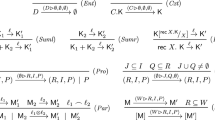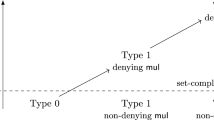Abstract
Reaction Systems (RSs) are a successful computational framework inspired by biological systems. A RS combines a set of entities with a set of reactions over them. Entities can be provided by an external context, used to enable or inhibit each reaction, and also produced by reactions. RS semantics is defined in terms of an (unlabelled) rewrite system: given the current set of entities, a rewrite step consists of the application of all and only the enabled reactions. In this paper we define, for the first time, a compositional labelled transition system for RSs with recursive and nondeterministic contexts, in the structural operational semantics (SOS) style. This is achieved by distilling a signature whose operators directly correspond to the ingredients of RSs and by defining some simple SOS inference rules for any such operator. The rich information recorded in the labels allows us to define an assertion language to tailor behavioural equivalences on some specific properties or entities. The SOS approach is suited to drive additional enhancements of RSs along features such as quantitative measurements of entities and communication between RSs. The SOS rules have been also exploited to design a prototype implementation in logic programming.
Research supported by MIUR PRIN 201784YSZ5 ASPRA, by U. of Pisa PRA_2018_66 DECLWARE, by U. of Sassari: Fondo di Ateneo per la ricerca 2020.
Access this chapter
Tax calculation will be finalised at checkout
Purchases are for personal use only
Similar content being viewed by others
Notes
- 1.
Conceptually, one could extend labels to record J and Q in separate positions from R and I, respectively, like in \(\langle W\vartriangleright R,J,I,Q,P\rangle \). However, one would then need to rewrite the side conditions of all the rules by replacing R with \(R\cup J\) and I with \(I\cup Q\), because the distinction is never exploited in the SOS rules.
- 2.
References
Azimi, S.: Steady states of constrained reaction systems. Theor. Comput. Sci. 701(C), 20–26 (2017). https://doi.org/10.1016/j.tcs.2017.03.047
Azimi, S., Iancu, B., Petre, I.: Reaction system models for the heat shock response. Fundam. Inf. 131(3–4), 299–312 (2014). https://doi.org/10.3233/FI-2014-1016
Barbuti, R., Gori, R., Levi, F., Milazzo, P.: Investigating dynamic causalities in reaction systems. Theor. Comput. Sci. 623, 114–145 (2016). https://doi.org/10.1016/j.tcs.2015.11.041
Barbuti, R., Maggiolo-Schettini, A., Milazzo, P., Troina, A.: Bisimulations in calculi modelling membranes. Form. Asp. Comput. 20(4), 351–377 (2008). https://doi.org/10.1007/s00165-008-0071-x
Bodei, C., Brodo, L., Bruni, R.: A formal approach to open multiparty interactions. Theor. Comput. Sci. 763, 38–65 (2019). https://doi.org/10.1016/j.tcs.2019.01.033
Bodei, C., Brodo, L., Bruni, R.: The link-calculus for open multiparty interactions. Inf. Comput. 275, 104587 (2020). https://doi.org/10.1016/j.ic.2020.104587
Bottoni, P., Labella, A., Rozenberg, G.: Networks of reaction systems. Int. J. Found. Comput. Sci. 31, 53–71 (2020). https://doi.org/10.1142/S0129054120400043
Brijder, R., Ehrenfeucht, A., Main, M., Rozenberg, G.: A tour of reaction systems. Int. J. Found. Comput. Sci. 22(07), 1499–1517 (2011). https://doi.org/10.1142/S0129054111008842
Brodo, L., Bruni, R., Falaschi, M.: Enhancing reaction systems: a process algebraic approach. In: Alvim, M.S., Chatzikokolakis, K., Olarte, C., Valencia, F. (eds.) The Art of Modelling Computational Systems: A Journey from Logic and Concurrency to Security and Privacy. LNCS, vol. 11760, pp. 68–85. Springer, Cham (2019). https://doi.org/10.1007/978-3-030-31175-9_5
Brodo, L., Bruni, R., Falaschi, M.: A process algebraic approach to reaction systems. Theor. Comput. Sci. (2020). https://doi.org/10.1016/j.tcs.2020.09.001. In Press
Cardelli, L., Gordon, A.D.: Mobile ambients. Theor. Comput. Sci. 240(1), 177–213 (2000). https://doi.org/10.1016/S0304-3975(99)00231-5
Cardelli, L., Tribastone, M., Tschaikowski, M., Vandin, A.: Forward and backward bisimulations for chemical reaction networks. In: CONCUR 2015, vol. 42, pp. 226–239. Schloss Dagstuhl Publ. (2015). https://doi.org/10.4230/LIPIcs.CONCUR.2015.226
Chiarugi, D., Falaschi, M., Olarte, C., Palamidessi, C.: Compositional modelling of signalling pathways in timed concurrent constraint programming. In: BCB 2010, pp. 414–417. ACM (2010). https://doi.org/10.1145/1854776.1854843
Corolli, L., Maj, C., Marinia, F., Besozzi, D., Mauri, G.: An excursion in reaction systems: from computer science to biology. Theor. Comput. Sci. 454, 95–108 (2012). https://doi.org/10.1016/j.tcs.2012.04.003
Falaschi, M., Olarte, C., Palamidessi, C.: Abstract interpretation of temporal concurrent constraint programs. Theory Pract. Logic Program. 15(3), 312–357 (2015). https://doi.org/10.1017/S1471068413000641
Falaschi, M., Olarte, C., Palamidessi, C.: A framework for abstract interpretation of timed concurrent constraint programs. In: PPDP 2009. pp. 207–218. ACM (2009). https://doi.org/10.1145/1599410.1599436
Falaschi, M., Palma, G.: A logic programming approach to reaction systems. In: DIP 2020. OASIcs, vol. 86, pp. 6:1–6:15. Schloss Dagstuhl-Leibniz-Zentrum für Informatik (2020). https://doi.org/10.4230/OASIcs.Gabbrielli.6
Gordon, A., Cardelli, L.: Equational properties of mobile ambients. Math. Struct. Comput. Sci. 13(3), 371–408 (2003). https://doi.org/10.1017/S0960129502003742
Hennessy, M., Milner, R.: On observing nondeterminism and concurrency. In: de Bakker, J., van Leeuwen, J. (eds.) ICALP 1980. LNCS, vol. 85, pp. 299–309. Springer, Heidelberg (1980). https://doi.org/10.1007/3-540-10003-2_79
Hillston, J.: A compositional approach to performance modelling. Ph.D. thesis, University of Edinburgh, UK (1994). http://hdl.handle.net/1842/15027
Kleijn, J., Koutny, M., Mikulski, Ł, Rozenberg, G.: Reaction systems, transition systems, and equivalences. In: Böckenhauer, H.-J., Komm, D., Unger, W. (eds.) Adventures Between Lower Bounds and Higher Altitudes. LNCS, vol. 11011, pp. 63–84. Springer, Cham (2018). https://doi.org/10.1007/978-3-319-98355-4_5
Milner, R. (ed.): A Calculus of Communicating Systems. LNCS, vol. 92. Springer, Heidelberg (1980). https://doi.org/10.1007/3-540-10235-3
Milner, R., Sangiorgi, D.: Barbed bisimulation. In: Kuich, W. (ed.) ICALP 1992. LNCS, vol. 623, pp. 685–695. Springer, Heidelberg (1992). https://doi.org/10.1007/3-540-55719-9_114
Okubo, F., Yokomori, T.: The computational capability of chemical reaction automata. Nat. Comput. 15(2), 215–224 (2015). https://doi.org/10.1007/s11047-015-9504-7
Plotkin, G.D.: A structural approach to operational semantics. Technical report DAIMI FN-19, Computer Science Department, Aarhus University (1981)
Plotkin, G.D.: An operational semantics for CSP. In: IFIP Working Conference on Formal Description of Programming Concepts - II, North-Holland, pp. 199–226 (1982)
Plotkin, G.D.: A structural approach to operational semantics. J. Log. Algebraic Methods Program. 60–61, 17–139 (2004). https://doi.org/10.1016/j.jlap.2004.05.001
Sangiorgi, D.: Introduction to Bisimulation and Coinduction. Cambridge University Press, USA (2011). https://doi.org/10.1017/CBO9780511777110
Acknowledgments
We thank the anonymous reviewers for their detailed and very useful criticisms and recommendations that helped us to improve our paper.
Author information
Authors and Affiliations
Corresponding author
Editor information
Editors and Affiliations
Rights and permissions
Copyright information
© 2021 Springer Nature Switzerland AG
About this paper
Cite this paper
Brodo, L., Bruni, R., Falaschi, M. (2021). SOS Rules for Equivalences of Reaction Systems. In: Hanus, M., Sacerdoti Coen, C. (eds) Functional and Constraint Logic Programming. WFLP 2020. Lecture Notes in Computer Science(), vol 12560. Springer, Cham. https://doi.org/10.1007/978-3-030-75333-7_1
Download citation
DOI: https://doi.org/10.1007/978-3-030-75333-7_1
Published:
Publisher Name: Springer, Cham
Print ISBN: 978-3-030-75332-0
Online ISBN: 978-3-030-75333-7
eBook Packages: Computer ScienceComputer Science (R0)




